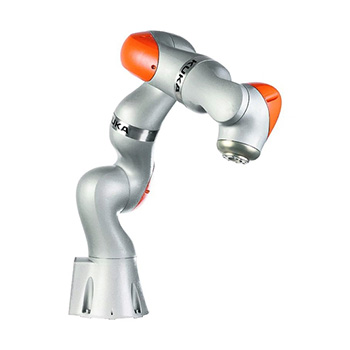The new LBR iiwa industrial lightweight robot by KUKA
KUKA’s new LBR iiwa lightweight robot with seven axes is designed in analogy to the human arm. It can be operated in position or compliance control mode. This, combined with the integrated sensor systems, endows the lightweight robot with programmable sensitivity. Its high-performance collision detection function and integrated joint torque sensors in all axes make the LBR iiwa an ideal solution for delicate joining processes and allow the use of simple tools. Its low weight, seven axis and streamlined design make it ideally suited to confined installation situations and allow easy integration into existing production systems. The LBR iiwa is available with payload capacities of 7 and 14 kilograms. KUKA thus offers the first, and so far only, lightweight robot with a payload capacity of over 10 kilograms.

Industrial lightweight robot LBR iiwa
Photo by KUKA
Exemplary Application at four fascinating stations
The LBR iiwa has opened up a new chapter in human-robot cooperation. It essentially functions as the operator’s third hand, thus offering companies a whole new range of potential applications without the need for safety fencing. Visitors to Hannover Messe were able to see this for themselves at four different demo stations. Four exhibits acquainted them with the advantages of the LBR iiwa.
The first station demonstrated the basic functions of the LBR iiwa. Here, visitors could guide the robot by hand and test various compliance parameters. At the “Weight” exhibit, trade fair visitors discovered that robots can show greater sensitivity than some people. The LBR iiwa is able to place a 10 kilo weight on scales in such a way that the scales only show 4 kilograms. At the “Water glass” exhibit, the LBR iiwa displayed its sensitive capabilities. Here, it traced a path on which the visitor could place a glass of water. With its responsive collision detection, the LBR iiwa stopped when it came into contact with the glass, without spilling any water. Last, but not least, the LBR iiwa demonstrated at Hannover Messe what its workstation could look like in an assembly shop. Here, it positioned a component over a pin and precisely joined both parts together.
For further information visit: www.kuka.com
News Categories
- » NEWS HOME
- » Automation & Robotics
- » Industry 4.0
- » Material Handling
- » Sensors
- » Quality & Testing
- » Machine Vision
- » Laser & Optics
- » Metalworking
- » Motion Control & Drives
- » Hydraulics & Pneumatics
- » Process Industry
- » Renewable Energy
- » Agriculture
- » Home & Office Furniture
- » Environmental Tech




